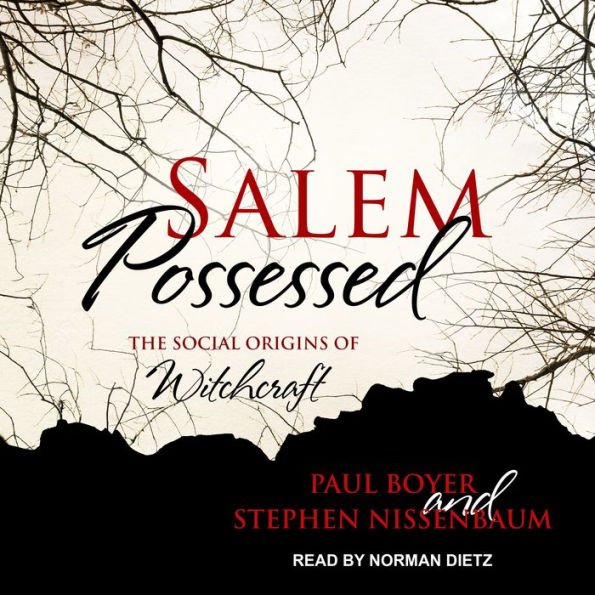An important, imaginative book that brings new insights to the study of the 1692 witchcraft outbreak in Massachusetts. Building on Charles Upham's Salem Witchcraft (1867), Boyer and Nissenbaum explore decades of community tension and conflict in order to explain why Salem was the focus of this episode. The authors reveal a complex set of relationships between persons allied with the growing mercantile interests of Salem Town and those linked to the subsistence-based economy of outlying Salem Village.
— Journal of Women in Culture and Society
Salem Possessed: The Social Origins of Witchcraft
Tormented girls writhing in agony, stern judges meting out harsh verdicts, nineteen bodies swinging on Gallows Hill. The stark immediacy of what happened in 1692 has obscured the complex web of human passion which climaxed in the Salem witch trials.
From rich and varied sources-many neglected and unknown-Paul Boyer and Stephen Nissenbaum give us a picture of the people and events more intricate and more fascinating than any other in the massive literature. It is a story of powerful and deeply divided families and of a community determined to establish an independent identity-beset by restraints and opposition from without and factional conflicts from within-and a minister whose obsessions helped to bring this volatile mix to the flash point. Not simply a dramatic and isolated event, the Salem outbreak has wider implications for our understanding of developments central to the American experience: the disintegration of Puritanism, the pressures of land and population in New England towns, the problems besetting farmer and householder, the shifting role of the church, and the powerful impact of commercial capitalism.
"1118666889"
From rich and varied sources-many neglected and unknown-Paul Boyer and Stephen Nissenbaum give us a picture of the people and events more intricate and more fascinating than any other in the massive literature. It is a story of powerful and deeply divided families and of a community determined to establish an independent identity-beset by restraints and opposition from without and factional conflicts from within-and a minister whose obsessions helped to bring this volatile mix to the flash point. Not simply a dramatic and isolated event, the Salem outbreak has wider implications for our understanding of developments central to the American experience: the disintegration of Puritanism, the pressures of land and population in New England towns, the problems besetting farmer and householder, the shifting role of the church, and the powerful impact of commercial capitalism.
Salem Possessed: The Social Origins of Witchcraft
Tormented girls writhing in agony, stern judges meting out harsh verdicts, nineteen bodies swinging on Gallows Hill. The stark immediacy of what happened in 1692 has obscured the complex web of human passion which climaxed in the Salem witch trials.
From rich and varied sources-many neglected and unknown-Paul Boyer and Stephen Nissenbaum give us a picture of the people and events more intricate and more fascinating than any other in the massive literature. It is a story of powerful and deeply divided families and of a community determined to establish an independent identity-beset by restraints and opposition from without and factional conflicts from within-and a minister whose obsessions helped to bring this volatile mix to the flash point. Not simply a dramatic and isolated event, the Salem outbreak has wider implications for our understanding of developments central to the American experience: the disintegration of Puritanism, the pressures of land and population in New England towns, the problems besetting farmer and householder, the shifting role of the church, and the powerful impact of commercial capitalism.
From rich and varied sources-many neglected and unknown-Paul Boyer and Stephen Nissenbaum give us a picture of the people and events more intricate and more fascinating than any other in the massive literature. It is a story of powerful and deeply divided families and of a community determined to establish an independent identity-beset by restraints and opposition from without and factional conflicts from within-and a minister whose obsessions helped to bring this volatile mix to the flash point. Not simply a dramatic and isolated event, the Salem outbreak has wider implications for our understanding of developments central to the American experience: the disintegration of Puritanism, the pressures of land and population in New England towns, the problems besetting farmer and householder, the shifting role of the church, and the powerful impact of commercial capitalism.
19.99
In Stock
5
1

Salem Possessed: The Social Origins of Witchcraft

Salem Possessed: The Social Origins of Witchcraft
FREE
with a B&N Audiobooks Subscription
Or Pay
$19.99
19.99
In Stock

Editorial Reviews
Product Details
| BN ID: | 2940171129293 |
|---|---|
| Publisher: | Tantor Audio |
| Publication date: | 04/17/2018 |
| Edition description: | Unabridged |
Videos

From the B&N Reads Blog
